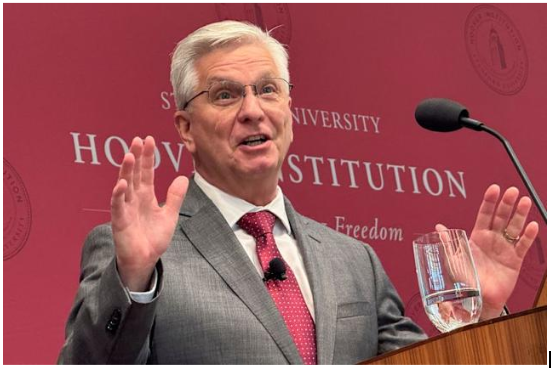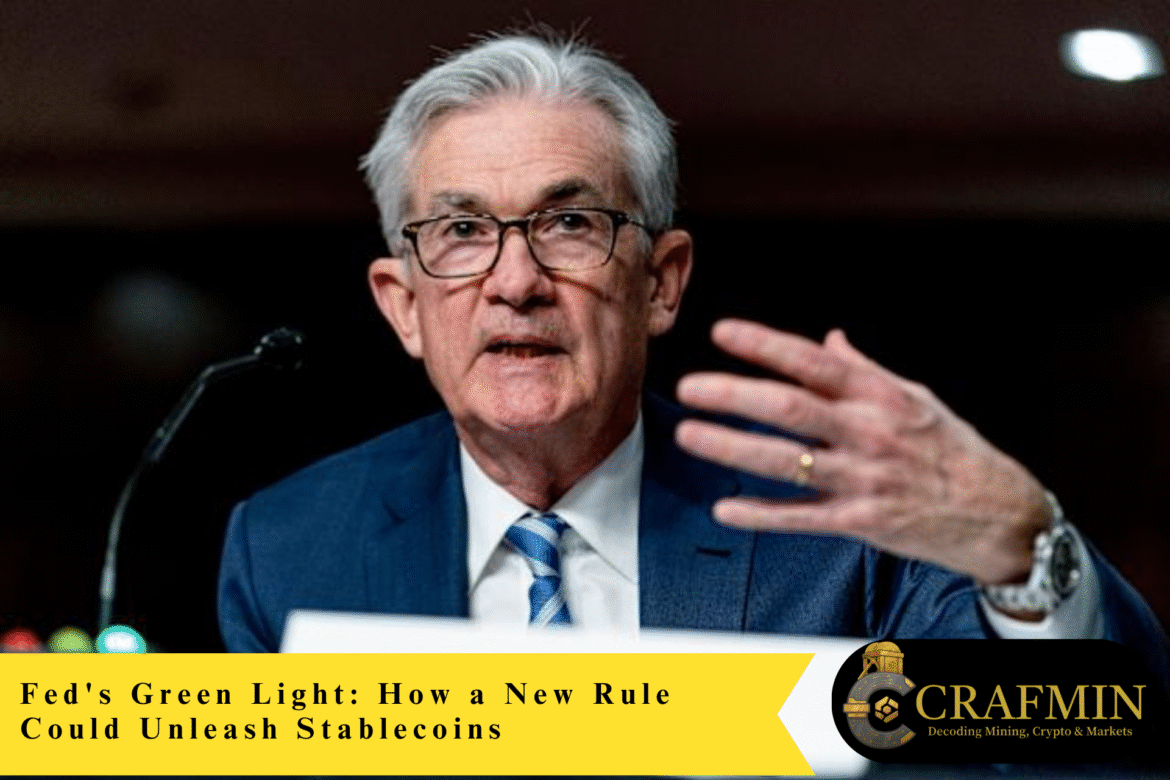The Federal Reserve is prodding the sea change softly. Introductory comments at a payments industry conference, Fed Governor Christopher Waller urged employees to think about a “payment account” or pared-down, i.e., “skinny” master account that would offer qualified fintechs and stablecoin issuers an appreciably less onerous portal into the heart of the U.S. payments system. That single sentence can redefine how dollar-pegged digital currency flows into consumer payment streams.

Fed’s Waller proposes a “skinny” account for fintech and stablecoin access. (Image Source: Yahoo Finance)
Why It’s Important
Fed master accounts are the conduits through which banks transfer central-bank money among themselves. By tradition, non-bank firms, a number of stablecoin issuers that fall into this category, don’t receive access to accounts and must rely on bank counterparty firms. Less costly, restricted access would offer a direct connection without full privilege accorded to banks. It’s an equitable midpoint: access with restraint.
Brief, Pithy Headline Summary
- The Fed is considering an experimental “payment account” to grant some non-bank payment innovators access to Fed payment rails.
- The accounts would likely be limited to no interest, no minimums, and no emergency credit as a way of keeping risk at arm’s length.
- The move is one of flat-out skepticism to cautiously testing stablecoins and decentralized payments technology.
The Picture Of Reality: What The Modern-Day “Streamlined Master Account” Looks Like
Envision a lean Fed ledger record entry enabling a compliant payments firm to settle enormous amounts of dollar transactions in batches. It’s not a bank account: envision capital controls on the balances, no overdraft facility, no discount window loans, and efficient screening. For dollar-pegged token issuers or payment processors, that’s an operating benefit, less middleman, less settlement risk, faster clearing.
For issuers of stablecoins, benefits can be decisive. Most obviously, maybe, is settlement finality: token issuers can better link token redemption to central-bank money, evading counterparty jumps and operational exposure that has caused some market jitters. For businesses and consumers, it could mean faster, lower-cost USD payments that are more like conventional bank transfers but without a bank balance sheet in the middle. (ledgerinsights)
A Thoughtful Turn, Not A Free Ride
Regulators are dividing two truths. Stablecoins introduce velocity and imagination. But they introduce bank-run behaviour and contagion risk when there are lines to be filled in times of stress. The Fed’s “skinny” account proposal leans both: it introduces access to infrastructure without foreclosing on limits to limit systemic risk. Waller and other Fed officials are guiding the path under which the central bank will participate in payments innovation, but on its terms.
Market And Industry Reaction: Real-Time Opinions
Crypto exchanges and payment firms were quick to react to the news. Top-tier newswires, specialty press, and trade publication coverage are optimistic to conservative. Some envision the path to mass adoption for USD stablecoins; others warn that banks and some regulators will be glacial in making access possible. Watch for incumbents lobbying and regulated stablecoin issuers competing to show compliance with whatever new standard is created.
Who Gains The Most In The Short Term?
- Issuers of already regulated stablecoins with transparency and custody will be the early movers they can be integrated into any successful mechanism the Fed constructs.
- Significant payment flow fintechs (payroll, remittance, merchant settlement) can minimise cost and friction.
- Big payment processors and merchants can gain from accelerated final settlement, enhancing day-end liquidity and reconciliation.
On “Skinny Master Accounts” at the Fedhttps://t.co/22xm5XYwTr
May potentially be a big deal for further legitimization of stablecoins and DeFi
Potential Winners:
∘ Crypto-native fintechs and stablecoin issuers like Custodia Bank and Kraken, who have struggled to get full… pic.twitter.com/D3PbrJbyJG— itscorrekt (@itscorrekt) October 22, 2025
Why Should Anyone Care?
Commercial banks stand to lose some of their settlement volume and fee revenue to direct entrants. That is why the Fed’s humble proposal of no interest caps is noteworthy: it protects bank deposit franchises from risk.
Hard-line regulators will demand hard guardrails: capital, custody rules, auditability, transparent contingency plans for stressed redemptions. Get ready for an epic battle between innovation and restraint.
A Human Experience: How This Would Feel On The Street
Consider a small Sydney or Sydney CBD café web shop receiving a payment in a stablecoin. In present conditions, the merchant would typically send tokens via a crypto exchange or payment gateway and then get settled on banking rails expensive, delayed transactions. With a streamlined Fed account for the issuer, settlements can be executed faster and more exchangeable straight to central-bank money, making cross-border payments faster and cheaper and stablecoin receipts equivalent to a deposit at a bank. That’s the promise to customers behind finagling policy. (goodwinlaw)

Streamlined Fed accounts could speed up Sydney café stablecoin payments. (Image Source: Facebook)
Gee-Whiz Tech And Regulatory Complications
Regulators and technologists already have concerns:
- How would balance limits be set and adjusted?
- Would such accounts support interoperability with instant payment systems, and, if so, on what terms would liquidity be managed?
- What are the operating protections (KYC, AML, custodial standards) to which an issuer would be subject?
- Who would enforce revocation of access under coercion?
These are not concepts; they’re the proximate nuts-and-bolts decisions Fed staff will consider next.
How The Fed Can Establish A “Skinny” Master Account: Three Models
Tiered Access With Hard Caps
The Fed gives very limited access to the ledger to non-bank firms. Balances are limited. No interest is being accrued. No last-resort lending. The Fed infrastructure is the pipes, but rules on transactions and liquidity constrain exposure at the system level. This is consistent with the public remark that Waller desires a thinner product with fewer “bells and whistles.”
Permissioned Rails + Custodial Overlay
Settlement is allowed by the Fed, but through custodial reserve holdings in highly liquid accounts at regulated intermediaries. Clearing and settlement are by the Fed, a buffer of custody with liquidity. This arrangement keeps the balance sheets of banks indirectly active and solves prudential problems in run risk and failure in custody. Custody and transparency are already mentioned to be in the list of main guardrails by most.
Hybrid Tokenised Settlement Pilot
The Fed permits experimentation in which tokenised dollar claims or tokenised reserves are held on private ledgers but gain finality on central-bank rails. The Fed’s “payment account” is the on-chain-to-off-chain bridge. It is technologically more sophisticated but preserves payment velocity while anchoring tokens on central-bank settlement. Waller’s tone suggests that the Fed is seeking real-world pilots, not baroque theory papers.
All the designs have the same goal: quicker, safer payment settling for payment innovators without risk management through the banking system. The differences in operation and law and that’s what determine whether stablecoins turn into a mass-market gadget or remain a niche plumbing kludge.
Timeline And Process Next Steps
The Fed has already progressed from private contemplation to public experiment. Witness this happen:
- Internal discussion and discussion between departments (weeks → months). Fed staff will develop operational, legal and risk dimensions. Waller has already asked staff to think through the idea in public.
- Public pilot proposals and stakeholder consultation (3–9 months). The Fed usually asks banks, fintechs and payment networks to pilot. Industry groups and Congress will offer feedback.
- Formal rulemaking and guidance (6–18 months). If the pilots are successful, the Fed may issue guidance on eligibility, limits, and operating requirements – but more substantive rulemaking to expand access even further would follow, especially if legislative repairs need to be formulated in areas like deposit insurance and consumer protection.
Key insight: public signaling stocks up timetables by focus but does not guarantee speed. The Fed stocks up because payment infrastructure errors have colossal impacts.
a vibe shift is taking place at the Fed, they’re actively exploring digital payments, hosting legitimate crypto builders, figuring out what the hell is x402 and experimenting with creating a skinny master account (plz name it fedChain) to make it easier for eligible companies to… pic.twitter.com/QPtKFWNhNi
— Yahya (@ya7ya) October 22, 2025
How It Reshapes The Economics Of Stablecoins
If redemptions are settled partly or in full by central-bank money-holding issuers, two economies change simultaneously:
Reduce Settlement Friction
Smaller correspondent steps mean lower operating expenses and quicker finality. That gets stablecoins nearer to card rails and bank transfers for merchant and cross-border use.
Liquidity Risk Reduction For Issuers
Settlement access instantly removes redemption mismatch risk and availability of reserves, provided caps and custody prerequisites are suitable. That lessens the risk of crisis liquidity shortfalls and can reduce the risk premia counterparties charge to manage stablecoin issuers.
Settlement charges will be eschewed by banks, but central credit and deposit facilities will be retained. Options in the Fed, namely ceilings and withheld discount-window access, are combined purposefully in such a way as to keep the balance intact. (goodwinlaw)
Summary Case Studies: How Leading Issuers Will Probably Respond
Circle (USDC) Circle is already building central-bank-like reserves and values transparency. A Fed narrow account would enable Circle to align USD redemptions even more tightly with central-bank settlement, eliminating counterparty steps and maybe float. Circle will quickly close the gap if it demonstrates good custody and compliance.
Paxos / Regulated Custody Issuers Businesses already operational in custodial or trust models can enter the Fed design first. Biggest fear: display controls and isolated custody are Fed-compliant.
Unregulated Issuers (Algorithmic Tokens, Etc.) They could be left behind or face a compliance barrier with high hurdles. Public comments emphasise supervised, legally qualified institutions, not edge cases for token templates.
Risk Scenarios: What Else Can Go Wrong
- Moral hazard creep. If the Fed appears to insure non-bank payment firms, market participants may overprice or underprice risk. The Fed will react with implicit limits, but clear legal limits require legislative codification.
- Operational fragmentation. Other competitor settlement models and technical pilots can fragment liquidity, and it becomes more difficult for merchants to settle. Here, the standard-setting role of the Fed is in effect.
- Regulatory arbitrage and foreign coordination. Foreign companies can sidestep high standards by staying away from where they are lower. The initial U.S. Fed move illustrates the EU, UK, Australia, and Asia coordination issue, but forces others to follow along, too.
Also Read: Are Crypto Privacy Coins Still Relevant in 2025?
What Australian Companies And Regulators Need To Watch Out For Now
- Integration Of Payment Infrastructure. Domestic fintechs must map how a US Fed “payment account” can be integrated into cross-border payment flows (FX conversion, cross-border liquidity, reconciliation).
- Compliance Minimum. Firms competing for direct access must enhance KYC/AML, custody transparency, auditability, and stress testing of liquidity.
- Merchant UX. Product teams can experiment with how token receipts map onto bank balances and how this affects merchants’ cash flow. Simple as that: adoption. (allens)

Aussie fintechs must align systems, boost compliance, and refine UX. (International Bar Association)
Final Read: What Success Would Mean, And What Failure Would Mean
Success: The Fed has a disciplined, regulated payment account. Regulated stablecoin issuers flow into it, settlement fees fall, and merchants use USD-pegged tokens for specific use cases (cross-border remittances, merchant settlement, distributed team payroll). Systemic risk and consumer protection are in the driver’s seat through regulation and constraints. The payment system is improved without compromising bank stability.
Failure: Rules get out of hand, pilots become short-term illiquid, or political resistance develops over-restrictive making direct access uneconomic. Or worse, a disastrous access design fuels runs or contagion and enhances skepticism, stifling innovation for years.
Frequently Asked Questions
Q: Is this a done deal?
A: No. Governor Waller asked Fed staff to weigh up the proposal. It’s not a rule, but only a proposal. Nevertheless, the Fed’s placing it there makes its chances of being taken to formal design and consultation much more likely.
Q: Will any crypto company be allowed in?
A: Unlikely. The plan is headed to qualified, regulated payment and innovation companies. Expect stringent compliance, custody, risk-management and likely balance limitations.
Q: Will it disinter banks?
A: Not in the short term. The “skinny” account idea specifically eliminates necessary bank benefits to avoid destabilizing the commercial banking business. It’s an access vehicle, not a banking charter.
Q: Will the move trigger stablecoin adoption in Australia and around the world?
A: A Fed move reduces global apprehension about USD stablecoins by less and can enable cross-border adoption. However, local regulation, business imperatives, and network effects will still prevail to drive adoption in Australia and elsewhere.
Q: Will the Fed replace dollar deposits?
A: No. The Fed product is meant to be free of core bank benefits like interest and emergency credit. It’s meant to lower payment innovator friction, not cut out retail deposit products.
Q: Would this lower payment costs a great deal?
A: Yes, by removing correspondent steps and settlement lag. Size would hinge on the adoption and access of issuers. Savings would be enormous for low-value micropayments and cross-border remittances.
Q: Do issuers have to be banks?
A: Not necessarily. Waller discusses legally qualified non-banks and banks in order to facilitate innovation. Eligibility will turn on supervision, custody, and controls, not company structure.
Q: From where is consumer protection originating?
A: Seek robust disclosure, reserve segregation, solidity and contingency planning for redemptions. The Fed will be acting in coordination with bank regulators and likely expecting public disclosure.
Q: Can Congress act?
A: Possibly. The Fed can create operating products, but broader regulatory overhauls, deposit insurance, and statutory definitions of money will need to be hammered out by lawmakers. The Fed’s open public study is subject to comment; lawmakers might have something to say.

